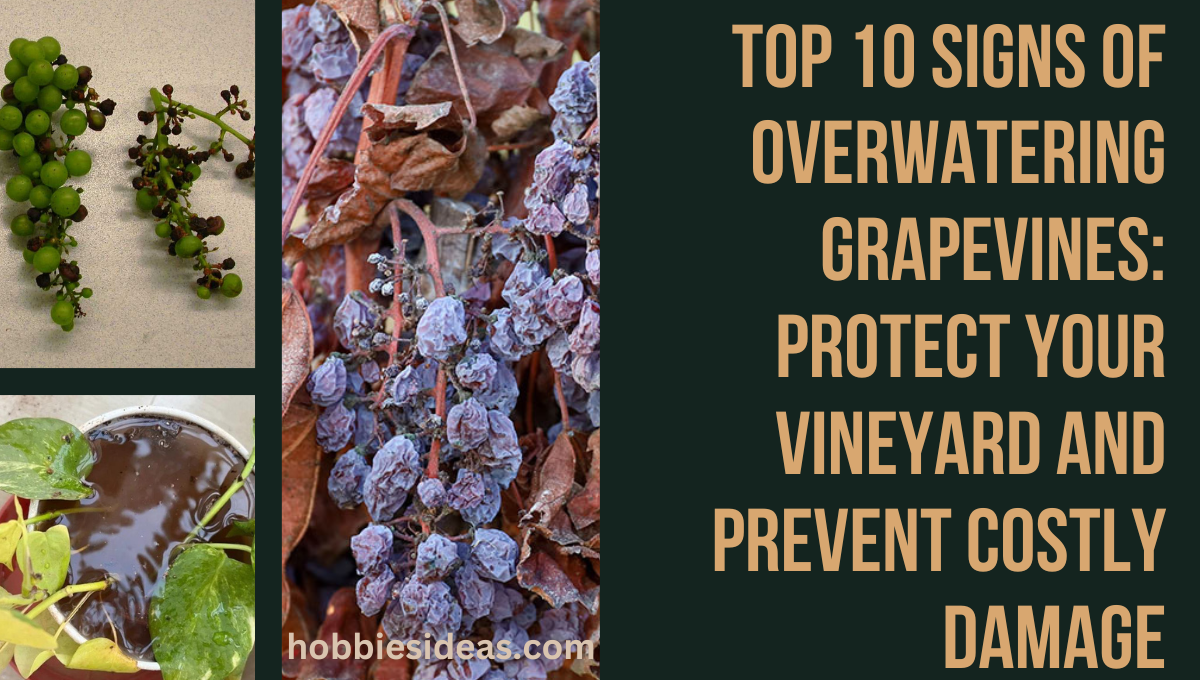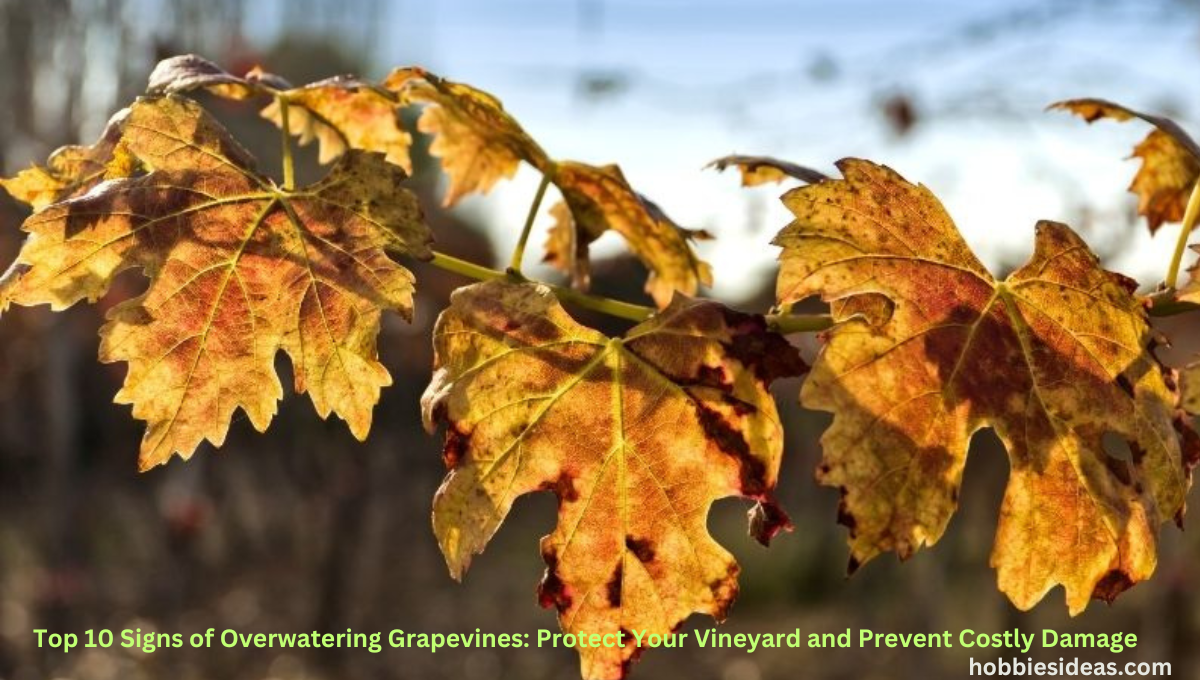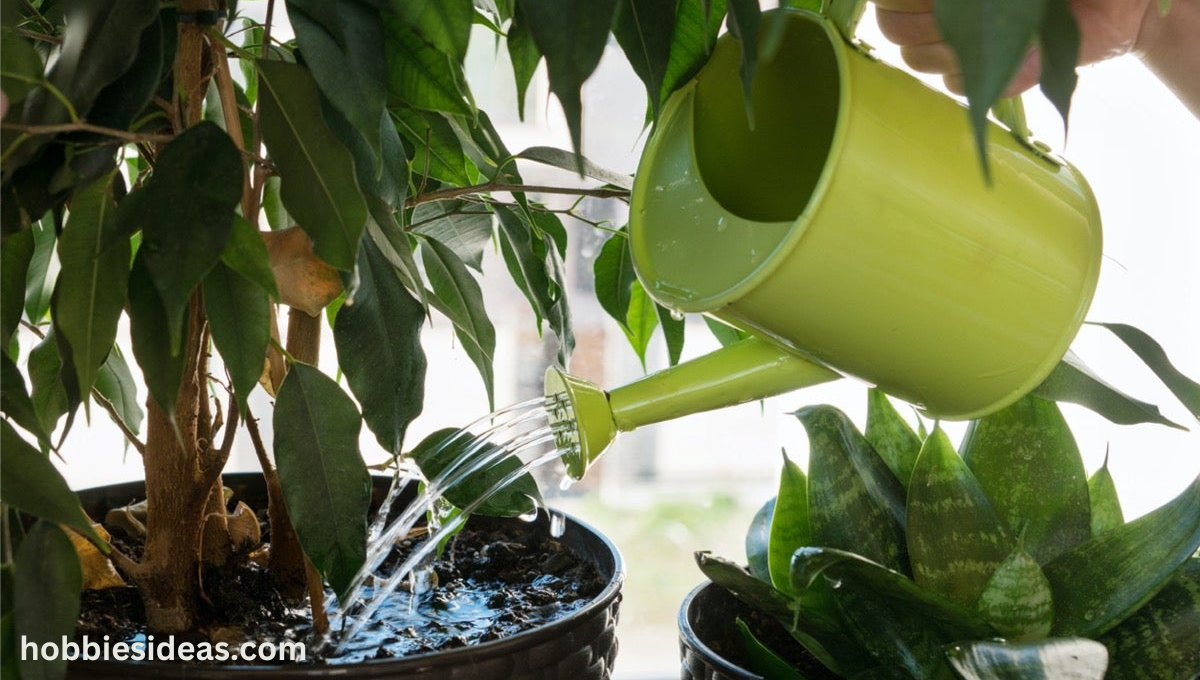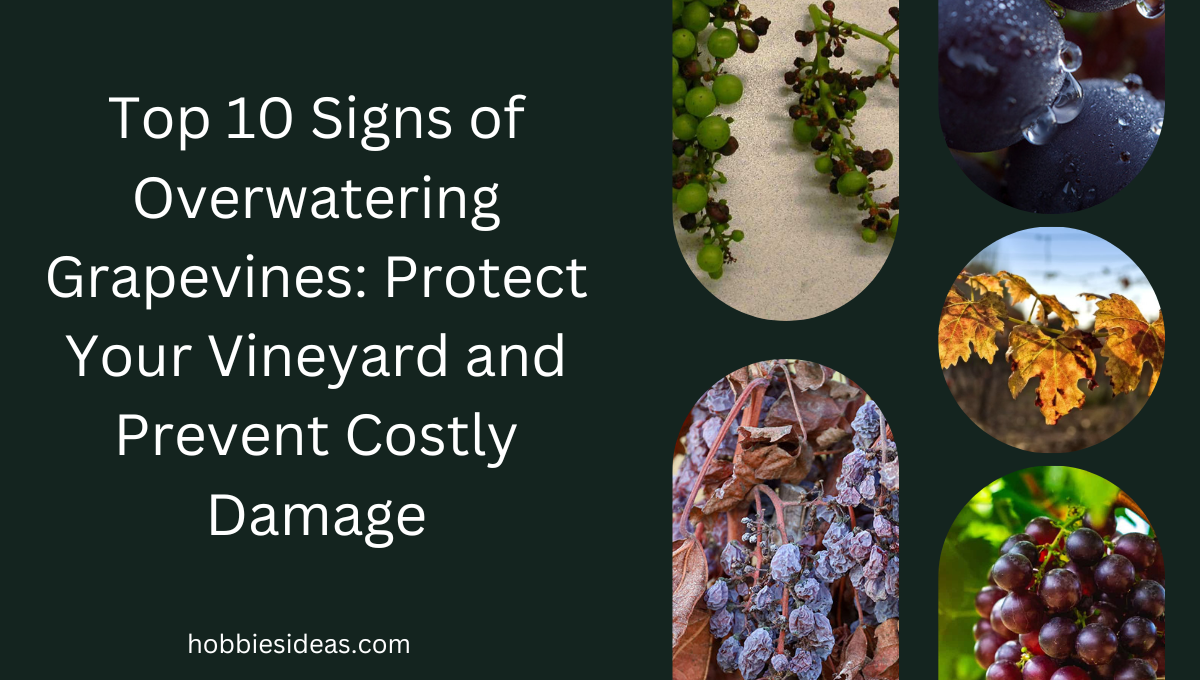Did you know that Overwatering Grapevines can be detrimental if done excessively? Overwatering can lead to drought stress and poor drainage, causing significant harm to these delicate plants. To maintain the health of your grapevines, it’s crucial to recognize signs of overwatering. Excessive water disrupts the nutrient balance in grapevines, hindering their growth and productivity. Look for signs like wilting leaves, yellowing foliage, or stunted growth. Monitoring soil moisture levels is essential, as overly saturated soil indicates overwatering. Understanding these signs and adopting proper irrigation practices ensure your wine grapes thrive without falling victim to this avoidable problem.
Overwatering can harm irrigating grapes’ well-being and productivity, especially wine grapes. Let’s explore some key indicators to help you identify when your vines are experiencing drought stress due to poor drainage.
Table of Contents
Understanding the Water Needs of Grapevines
Like other plants, grapevines require a careful water balance to thrive and produce quality wine. However, understanding their specific water requirements during drought can be crucial in ensuring their health and productivity. Let’s delve into the factors that influence grapevine’s water needs and how overwatering can adversely affect their growth during periods of little rain.
Grapevines, especially wine grapes, have specific watering needs that should be adjusted according to their growth stages. This is particularly important during droughts, as these plants require adequate water to thrive.
A grapevine undergoes different growth stages throughout its lifecycle, each with varying water needs. Grapevines require moderate watering to support healthy growth during the initial phase and the break and shoot development stages. As they progress into flowering and fruit set stages, their demand for water increases significantly to facilitate optimal fruit development. Finally, during the ripening phase, grapevines need less water, as excessive irrigation at this point can dilute the flavors of the grapes. The water needs of the grapevines are influenced by factors such as rain and stomatal conductance.
Factors like soil type and climate can impact the water needs of wine grapes, causing potential stress on the plants.
Soil type is vital in determining how much water young wine grape vines require. Well-draining soils allow excess moisture to escape quickly, preventing issues such as root rot caused by overwatering. On the other hand, clayey or compacted soils may retain more water than necessary, leading to stagnant conditions that are detrimental to root health and pressure the plants.

The climate also plays a vital role in grapevine irrigation management. In arid regions where rainfall is scarce, and temperatures are high, grapevines may need additional irrigation to meet the demands of thirsty plants. Conversely, cooler climates with higher precipitation levels may require minimal supplemental watering for the grapes.
Monitoring soil moisture levels helps determine when to water grapevines, ensuring optimal conditions for the growth and development of grape plants. This is crucial for producing high-quality grapes that are essential for making wine. By monitoring soil moisture levels, grape growers can apply water at the right time and amount, preventing issues such as drought stress or excessive pressure on the plants.
To ensure optimal growth of grape plants and the production of high-quality wine, it is crucial to monitor soil moisture levels regularly. This can be accomplished using tools such as tensiometers or sensors placed at various depths within the soil profile. By doing so, you can prevent overwatering and underwatering, which can negatively impact the pressure and quality of the grapes.
By tracking the water potential of the soil, you can assess whether your grapevines are experiencing water stress or receiving sufficient moisture for wine production. Monitoring leaf and stem water potential also provides valuable insights into the overall hydration status of the vine, helping to address any issues related to grapes and their growth.
Overwatering grapes can cause stress and hinder leaf development, affecting grapevines’ root development and nutrient absorption.
While providing adequate water is crucial for the health of young grapevines, overwatering can cause stress and harm their growth. Excessive irrigation can lead to poor root development as the roots of the young vines become deprived of oxygen due to saturated soil conditions. This impedes their ability to absorb essential nutrients from the soil, ultimately affecting the quality of the grapes and the health of the leaves.
Moreover, overwatered grapevines are more susceptible to stress and diseases like fungal infections that thrive in moist environments. These diseases can compromise both vine health and fruit yield, affecting the leaves.
How to Prevent Overwatering Grapevines: Best Practices
Implement a regular watering schedule based on vine needs and weather conditions.
To prevent stress on grapevines, it is crucial to establish a regular watering schedule that considers the grapes’ specific needs and prevailing weather conditions. Grapevines generally require moderate amounts of water, and providing them with too much can have detrimental consequences for the grapes and their leaves.
One practical grapevine-growing approach is to water the plants deeply but infrequently. This means giving the grapes a thorough soaking, allowing the water to penetrate the soil and reach the roots. Deep watering encourages the development of robust root systems, making the vines more resilient during dry periods. However, avoiding excessive time between watering sessions is essential, as this can stress the grape plants.
Use well-draining soil and avoid excessive irrigation or rainfall accumulation around vines.
Choosing the right type of soil for your grapevines, such as sandy loam or loamy soils, is crucial in preventing overwatering. These soil types effectively drain excess water away from the roots, reducing the risk of stress for the grapes. Avoid heavy clay soils that retain moisture for extended periods, as they can lead to overwatering and leaf damage.
It is essential to avoid excessive irrigation or letting rainfall accumulate around your grapevines. Regularly inspect your vineyard after heavy rains and ensure proper drainage channels are in place to prevent stress on the grapes. If you notice standing water around your vines, improve drainage or use contour plowing or raised beds to reduce stress.
Mulching helps retain moisture while preventing excess water retention near roots.
Mulching is an excellent practice that aids in retaining moisture in the soil near grapevine roots. Applying a layer of organic mulch around each vine creates a protective barrier that reduces evaporation and helps maintain a consistent soil moisture level, benefiting the growth of vines and grapes while reducing stress.
When mulching grapevines, use organic materials such as straw, wood chips, or compost to help retain water and prevent plant stress. These materials have moisture and gradually decompose, enriching the soil with essential nutrients. Apply a layer of mulch around 2–3 inches thick, leaving some space around the vine’s base to prevent rotting. Monitoring leaf and stem water potential can also help assess the plant’s water needs.
Adjust the watering frequency during different growth stages to prevent overhydration.
Grapevines, like grapes, go through various growth stages throughout the year. Their water requirements for grapes vary accordingly. Adjusting your watering frequency accordingly is crucial to avoid overwatering grapes during specific growth stages.
During the initial stage of bud break and shoot development in spring, grapevines require more water to support their rapid growth. However, once they enter the flowering and fruiting phases, it is essential to reduce watering, as excessive watering can lead to swollen berries or diluted flavors in the grapes.
As grape harvest approaches and the grape variety vines enter dormancy in late summer or early fall, watering is gradually reduced. This allows the grape variety vines to prepare for winter without excess moisture in their system, reducing the risk of diseases caused by damp conditions.
By following these best practices for preventing overwatering in grapevines, you can ensure healthy growth and maximize your vineyard’s productivity while avoiding potential issues associated with excessive water intake. Grapes are a delicate crop that requires careful irrigation to thrive.
Assessing Vine Health: Signs of Overwatering in Grapevines
Yellowing leaves, especially at the bottom of the grapevine, may indicate overwatered grapes. When grapevines receive excessive water, the roots become saturated and struggle to absorb oxygen. This lack of oxygen affects the plant’s ability to perform essential functions, leading to yellowing leaves. The discoloration typically starts at the grapevine’s lower part because excess water accumulates in the soil around its base.

Wilting or drooping foliage could be a sign of under- or overwatered grapevines, so assessing other factors is essential. While wilting can occur due to insufficient water supply, it can also indicate that your grapevine is receiving too much water. Overwatered grapevines experience root damage and reduced nutrient absorption, causing their leaves to wilt and droop. To determine if overwatering is the culprit behind wilting foliage, consider factors such as recent rainfall or irrigation practices.
Stunted growth and reduced fruit production may result from chronic overhydration in grapevines. Excessive watering inhibits root development and disrupts nutrient uptake in grapes. As a result, these plants struggle to grow properly and produce healthy grapes. If you notice that your grapevine is not growing as vigorously as expected or if there is a decline in grape yield despite favorable conditions, overwatering could be a contributing factor.
Excessive moisture can cause root rot in grapevines, leading to decline or death. When exposed to overly wet conditions, the roots of grapevines are vulnerable to fungal infections like root rot. This disease damages the roots’ structure and function, impacting their ability to provide nutrients and support. Affected vines may exhibit symptoms of decline, including withered leaves and weakened stems, and may ultimately perish if untreated.
Tips for Properly Watering Grapevines in the Garden
Watering grapevines in the garden is crucial for healthy growth and abundant fruit production. Here are some tips to effectively water your grapes.
Water deeply but infrequently
Grapevine’s general rule of thumb is to water deeply but infrequently. This allows the top few inches of soil around the grape vines to dry out between watering sessions. By doing so, you encourage the roots of the grape vines, which are responsible for absorbing nutrients, to grow deeper into the ground. This promotes better nutrient absorption and overall health for the grape vines.
Direct irrigation towards the base of the plant
When watering your grapevines, it’s crucial to direct irrigation towards the base of the grapes rather than wetting the foliage excessively. This helps prevent fungal diseases that thrive in moist environments and reduces water waste. By focusing on the root zone of the grapes, you ensure that water reaches where it’s needed most.
Monitor weather conditions and adjust watering accordingly.
Regularly monitoring weather conditions is essential to avoiding overwatering or underwatering your grapevines. If there has been significant rainfall or if the soil feels damp, reduce the frequency of watering sessions for your grapes. On the other hand, increase watering as necessary during hot and dry periods. Adapting your watering routine based on weather patterns provides optimal grapevine growing conditions.
Avoid overhead sprinklers
While overhead sprinklers may seem convenient for watering multiple plants simultaneously, they can harm grapevines. Overhead sprinklers promote excessive moisture on foliage, leading to fungal diseases such as powdery or downy mildew. Using sprinklers wastes water through evaporation and runoff instead of delivering it directly where it’s needed—on the roots of the grapes.
Instead of relying solely on sprinklers, consider alternative watering methods such as drip irrigation or soaker hoses for grape vines. These targeted systems efficiently deliver water to the root zone, minimizing waste and reducing the risk of fungal diseases that can affect grapes.
Following these tips, you can avoid common pitfalls and properly water your grapevines in the garden. Remember to water deeply but infrequently, direct irrigation towards the base of the grape plant, monitor weather conditions and avoid overhead sprinklers. With a bit of care and attention, your grapevines will thrive and reward you with bountiful harvests of grapes year after year. So grab that hose or watering can and give your grapevines the hydration they need for success!
Addressing Nutrient Imbalances Caused by Overwatering
Overwatering grapevines can harm grapevines, leaching essential nutrients from the soil and leading to nutrient deficiencies. When grapevines are exposed to excessive moisture, their ability to uptake grapes through their roots is hindered, resulting in imbalances that can negatively impact grape health and productivity.
Regular soil testing is crucial in identifying nutrient deficiencies or excesses caused by grapevine overwatering. By analyzing the composition of the soil, grape growers can gain valuable insights into the specific nutrient requirements of their grapes. Soil tests provide information about pH levels, nutrient content, and other factors influencing grape plant health.
Based on the results of soil tests, adjustments should be made to fertilization practices for grape vines to restore proper nutrient levels. Applying too much fertilizer can exacerbate the issue of overwatering and lead to further imbalances in grapes. It is essential to provide adequate nutrition for the vine’s needs without overwhelming them with excessive fertilizer.
One solution to address nutrient imbalances caused by overwatering is to incorporate organic matter, such as compost, into the soil. Compost improves soil structure, enhances moisture retention, and promotes microbial activity. This creates a healthier environment for grapevine roots, supporting better nutrient uptake for the vines.
Maintaining proper pH levels in the soil is crucial for optimal nutrient absorption by grapevines. Overwatering can often result in an increase in soil pH due to the leaching of certain minerals. Adjustments may need to be made using appropriate amendments or treatments, such as sulfur or lime applications.
To prevent root rot in grapevines caused by overwatering, ensuring proper drainage in vineyard soils is crucial. Excessive waterlogging conditions create an anaerobic environment where grape root rot pathogens thrive. Implementing drainage systems or planting grapevines on slopes can help alleviate this issue.
Troubleshooting Overwatering Issues in Grapevines
Check for proper drainage and consider improving it if excessive water accumulates around vines.
One of the first signs of overwatering grapevines is poor drainage. If water accumulates around the vines and does not drain properly, it can lead to root rot and other issues that affect the plant’s overall health. It is essential to assess the drainage system in place. Consider these steps to improve drainage:

- Inspect the soil: Determine if the soil composition is suitable for good drainage. Sandy loam soils are ideal for grapevines, as they provide adequate drainage while retaining some moisture.
- Amend the soil: If you have heavy clay or compacted soil, amend it with organic matter such as compost or well-rotted manure. This helps improve its structure and promote better drainage.
- Create a slope: If your vineyard is flat, consider a slight slope to encourage water runoff away from the vines.
- Install drains: In areas prone to excessive water accumulation, installing gutters can be an effective solution. French drains or underground perforated pipes can help redirect excess water away from the roots.
Inspect irrigation systems for leaks or malfunctions that may contribute to overwatering.
Another common cause of overwatering in grapevines is faulty irrigation systems. Regularly inspect your irrigation setup for any leaks or malfunctions that could be contributing to excessive watering.
- Check sprinkler heads to ensure they are not causing plant water stress by spraying directly onto the grapes or causing puddles around the vines.
- Examine drip lines for leaks along grape vines that may deliver too much water to specific areas.
- Test grape vine timers: Make sure grape vine timers are functioning correctly and accurately, controlling watering schedules.
Prune dense foliage to improve air circulation and reduce moisture retention.
Dense foliage on grape vines can hinder air circulation and increase moisture retention, creating a favorable environment for overwatering issues. Regular pruning of grape vines helps maintain an open canopy and allows better airflow.
- Remove excess shoots from grape vines to promote better air circulation and reduce plant water stress. Thin out crowded areas within the vine to maintain optimal stem water potential.
- Trim excessive leaves: Prune away excessive foliage on grape vines that may be blocking sunlight and contributing to plant water stress, preventing proper evaporation of moisture, and affecting water potential.
- Train grape vines properly: Use trellises or other support systems to guide the growth of grape vines, ensuring they are not overly dense. This is important to prevent water stress and maintain optimal water potential for grape production.
Monitor weather forecasts to adjust watering schedules accordingly.
Monitoring weather forecasts regularly is crucial to preventing overwatering grape vines. Adjust your watering schedule based on predicted rainfall and temperature conditions.

- Reduce irrigation during rainy periods: If rain is expected, skip scheduled watering sessions for grape vines to avoid over-saturating the soil.
- Increase irrigation for grape vines during dry spells: Consider increasing the watering frequency or duration if extended dry periods are forecast.
Following these troubleshooting steps can effectively address overwatering issues in grapevines. Remember that maintaining proper drainage, inspecting irrigation systems, pruning dense foliage, and adjusting watering schedules according to weather conditions are essential for promoting healthy grapevine growth and preventing water-related problems.
Conclusion for Overwatering Grapevines:
Maintaining healthy grapevines through proper watering is crucial for their growth and productivity. By understanding the water needs of grapevines, preventing overwatering, assessing vine health, and addressing nutrient imbalances caused by excessive watering, you can ensure the optimal development of your grapevines.
Proper watering involves finding a balance between providing enough water to meet the plant’s needs without drowning the roots. Signs of overwatering in grapevines include yellowing leaves, wilting despite sufficient moisture, root rot, and stunted growth. By being vigilant and recognizing these signs early on, you can take prompt action to rectify any overwatering issues.
To properly water grapevines in your garden or vineyard, consider soil type, weather conditions, and the growth stage. Providing deep but infrequent watering sessions encourages strong root development while minimizing the risk of overwatering. Ensuring proper drainage in the planting area helps prevent waterlogged soil that can lead to root problems.
Overwatering can also cause nutrient imbalances in grapevines. Excessive moisture can leach essential nutrients from the soil or disrupt their uptake by roots. Regularly monitoring soil pH levels and conducting leaf tissue analysis will help identify deficiencies or excesses that need to be addressed through appropriate fertilization methods.
Troubleshooting becomes necessary if you encounter overwatering issues with your grapevines despite following best practices. This may involve adjusting irrigation schedules or methods, improving soil drainage through amendments like organic matter or gravel, or seeking professional advice if the problem persists.
In conclusion, maintaining healthy grapevines requires proper watering techniques to avoid overwatering. By understanding their water needs, preventing excessive moisture accumulation around roots, assessing signs of overwatering promptly, addressing nutrient imbalances caused by too much water, and troubleshooting any issues, your grapevines will thrive and produce bountiful harvests.
Remember, healthy grapevines are the foundation for flavorful wines and delicious table grapes. So, take care of your vines, provide them with the right amount of water, and watch them flourish!
Frequently Asked Questions
How often should I water my grapevines?
Proper watering frequency for grape vines depends on soil type, weather conditions, and growth stage. As a general guideline, aim to provide deep watering sessions for grape vines every 7–10 days during dry periods.
Can overwatering grapevines kill them?
Overwatering can lead to root rot and other problems that eventually kill grapevines. It is important to monitor soil moisture levels and signs of overwatering to prevent plant damage.
What are the signs of overwatered grapevines?
Signs of overwatering in grapevines include yellowing leaves, wilting despite sufficient moisture, root rot or fungal diseases, stunted growth, and an unpleasant odor from the soil.
How do I improve drainage around my grapevines?
To improve drainage around your grapevines, you can amend the soil with organic matter like compost or add gravel or sand to increase permeability. This helps excess water drain more efficiently.
Can overwatering affect fruit production in grapevines?
Yes, overwatering can negatively impact fruit production on grapevines. Excessive moisture can lead to poor pollination, reduced sugar accumulation in berries, increased disease susceptibility, and lower yields.
Should I water my grapevines during the winter?
In most cases, watering your grapevines during the winter when they are dormant is unnecessary. However, occasional light watering may be necessary for an extended period without rainfall or if you live in an arid region where winters are dry.
Can I use a sprinkler system to water my grapevines?
While sprinkler systems can be used for watering grapevines, ensuring that the water reaches the root zone effectively is essential. Drip irrigation or soaker hoses are generally more efficient methods as they deliver water directly to the base of the plants.
How can I prevent nutrient imbalances caused by overwatering?
To prevent nutrient imbalances caused by overwatering, regularly monitor the soil pH levels of grape vines and conduct leaf tissue analysis.

